Refine search
Actions for selected content:
2643 results in Civil and geotechnical engineering
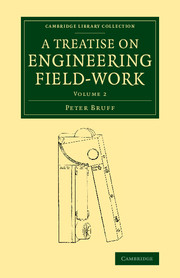
A Treatise on Engineering Field-Work
- Comprising the Practice of Surveying, Levelling, Laying Out Works, and Other Field Operations
-
- Published online:
- 05 June 2015
- Print publication:
- 21 August 2014
- First published in:
- 1842
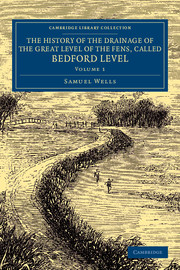
The History of the Drainage of the Great Level of the Fens, Called Bedford Level
- With the Constitution and Laws of the Bedford Level Corporation
-
- Published online:
- 05 June 2015
- Print publication:
- 20 November 2014
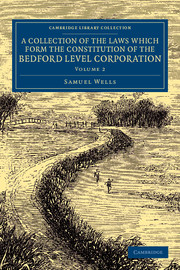
A Collection of the Laws Which Form the Constitution of the Bedford Level Corporation
-
- Published online:
- 05 June 2015
- Print publication:
- 20 November 2014

A Treatise on Roads
- Wherein the Principles on Which Roads Should Be Made Are Explained and Illustrated, by the Plans, Specifications, and Contracts Made Use of by Thomas Telford, Esq., on the Holyhead Road
-
- Published online:
- 05 June 2015
- Print publication:
- 25 September 2014
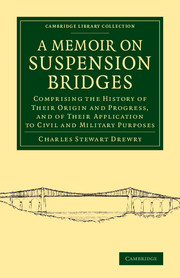
A Memoir on Suspension Bridges
- Comprising the History of their Origin and Progress, and of their Application to Civil and Military Purposes
-
- Published online:
- 05 June 2015
- Print publication:
- 21 August 2014
- First published in:
- 1832
4 - Introduction of Relevant Terms, Concepts, and Technologies
-
- Book:
- Robot-Oriented Design
- Published online:
- 05 May 2015
- Print publication:
- 05 May 2015, pp 49-124
-
- Chapter
- Export citation
8 - Competitive Advantage by Co-adapted Expansion of Products and Manufacturing Systems
-
- Book:
- Robot-Oriented Design
- Published online:
- 05 May 2015
- Print publication:
- 05 May 2015, pp 256-260
-
- Chapter
- Export citation
3 - The Role of Complementarity of Products, Organization, Information, and Machine Technology
-
- Book:
- Robot-Oriented Design
- Published online:
- 05 May 2015
- Print publication:
- 05 May 2015, pp 21-48
-
- Chapter
- Export citation
Glossary
-
- Book:
- Robot-Oriented Design
- Published online:
- 05 May 2015
- Print publication:
- 05 May 2015, pp xiii-xxiv
-
- Chapter
- Export citation
5 - Complex Products in Other Industries and Relevance of Fixed-Site/On-Site Manufacturing Technology
-
- Book:
- Robot-Oriented Design
- Published online:
- 05 May 2015
- Print publication:
- 05 May 2015, pp 125-155
-
- Chapter
- Export citation
References
-
- Book:
- Robot-Oriented Design
- Published online:
- 05 May 2015
- Print publication:
- 05 May 2015, pp 261-274
-
- Chapter
- Export citation
7 - Utilizing Innovation Science to Develop and Deploy Automated/Robotic Systems in Construction
-
- Book:
- Robot-Oriented Design
- Published online:
- 05 May 2015
- Print publication:
- 05 May 2015, pp 231-255
-
- Chapter
- Export citation
2 - The Structure of this Volume
-
- Book:
- Robot-Oriented Design
- Published online:
- 05 May 2015
- Print publication:
- 05 May 2015, pp 18-20
-
- Chapter
- Export citation
1 - Advanced Construction and Building Technology
-
- Book:
- Robot-Oriented Design
- Published online:
- 05 May 2015
- Print publication:
- 05 May 2015, pp 1-17
-
- Chapter
-
- You have access
- HTML
- Export citation
Copyright page
-
- Book:
- Robot-Oriented Design
- Published online:
- 05 May 2015
- Print publication:
- 05 May 2015, pp iv-iv
-
- Chapter
- Export citation
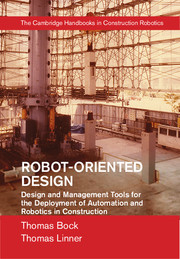
Robot-Oriented Design
- Design and Management Tools for the Deployment of Automation and Robotics in Construction
-
- Published online:
- 05 May 2015
- Print publication:
- 05 May 2015
Contents
-
- Book:
- Robot-Oriented Design
- Published online:
- 05 May 2015
- Print publication:
- 05 May 2015, pp v-viii
-
- Chapter
- Export citation
6 - Synchronization of Organization, Building Structure, and Manufacturing Technology by Robot-Oriented Design
-
- Book:
- Robot-Oriented Design
- Published online:
- 05 May 2015
- Print publication:
- 05 May 2015, pp 156-230
-
- Chapter
- Export citation
Robot-Oriented Design - Half title page
-
- Book:
- Robot-Oriented Design
- Published online:
- 05 May 2015
- Print publication:
- 05 May 2015, pp i-ii
-
- Chapter
- Export citation
Acknowledgements
-
- Book:
- Robot-Oriented Design
- Published online:
- 05 May 2015
- Print publication:
- 05 May 2015, pp ix-xii
-
- Chapter
- Export citation
